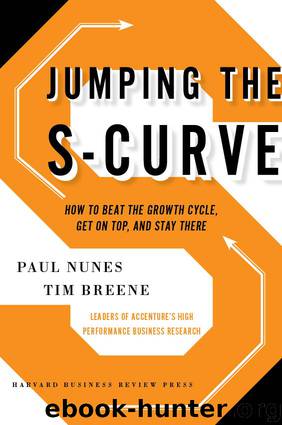Jumping the S-Curve: How to Beat the Growth Cycle, Get on Top, and Stay There by Paul F. Nunes & Tim Breene

Author:Paul F. Nunes & Tim Breene
Language: eng
Format: mobi
Publisher: Harvard Business Review Press
Published: 2011-02-23T14:00:00+00:00
STRATEGY AT THE EDGE OF THE ORGANIZATION
At low- and average-performance businesses, strategy is typically devised and dictated from the center of the organization. Top executives meet on a regular basis and determine which markets to enter (and which to exit), and they try to predict how the organization’s basis of competition will evolve in the future. At high-performance companies, strategy is more of an organic process that frequently emerges from the periphery of the organization. Frontline employees might, for example, have key customer information that leads to a BEMI, or a regional office might have noticed some important demographic trend. Accordingly, high-performance companies have processes in place to ensure that those peripheral sources are incorporated when the company is devising and developing strategy.
Make Peripheral Businesses the Center of Attention
Savvy executives have long realized that important innovations often come from regional operations. Case in point: Vick’s Cough Syrup with Honey, a new over-the-counter remedy. The homeopathic product was developed in P&G’s labs in Caracas, Venezuela, for sale in Mexico and other Latin American countries. But after its success there, P&G began marketing it in the United States and Europe. Such reverse, or trickle-up, innovations not only have become a significant source of revenue for companies like P&G, they have also altered the product strategies at those organizations. The traditional approach was to develop products for consumers in the United States, Europe, and Japan and then sell stripped-down, cheaper versions of those items in emerging countries. Now companies are realizing that the “bottom of the pyramid” contains not only opportunities to sell goods but also sources of innovations. “Many of the business solutions America needs for the next 50 years could be found in emerging markets,” asserts Vijay Govindarajan, a professor at Dartmouth’s Tuck School of Business.20
To take advantage of any opportunities that might come from peripheral businesses, many high-performance businesses have shunned top-down organizational structures. They have decentralized the decision-making process, empowering managers at local business units with enough flexibility to quickly capitalize on market opportunities. When the manager of a Best Buy store in New York City discovered a large Brazilian community nearby, he went about catering to that market segment, first by hiring employees who could speak Portuguese. Then, after learning that large cruise ships of Brazilians often stopped in New York City, he contacted the travel company, and before long, busloads of the tour groups were visiting the store for shopping sprees. “If we waited for someone in Minnesota to come up with that idea, we’d still be waiting,” said former CEO Brad Anderson at the time, referring to the company’s Midwest headquarters. “I believe that some of our best ideas have come from the people who are furthest removed from the CEO’s office—those line-level employees who interact with our customers each and every day.”21
A similar philosophy permeates Illinois Tool Works (ITW). In fact, decentralized decision-making is so much a part of the company that it is organized basically as a holding corporation with literally hundreds of independent business units.
Download
This site does not store any files on its server. We only index and link to content provided by other sites. Please contact the content providers to delete copyright contents if any and email us, we'll remove relevant links or contents immediately.
Bad Blood by John Carreyrou(6275)
Rich Dad Poor Dad by Robert T. Kiyosaki(6175)
Principles: Life and Work by Ray Dalio(5961)
Playing to Win_ How Strategy Really Works by A.G. Lafley & Roger L. Martin(5500)
Management Strategies for the Cloud Revolution: How Cloud Computing Is Transforming Business and Why You Can't Afford to Be Left Behind by Charles Babcock(4438)
The Confidence Code by Katty Kay(4038)
Thinking in Bets by Annie Duke(3996)
American Kingpin by Nick Bilton(3508)
Delivering Happiness by Tony Hsieh(3283)
Project Animal Farm: An Accidental Journey into the Secret World of Farming and the Truth About Our Food by Sonia Faruqi(3018)
The Power of Habit by Charles Duhigg(2966)
Brotopia by Emily Chang(2896)
Mastering Bitcoin: Programming the Open Blockchain by Andreas M. Antonopoulos(2891)
The Tyranny of Metrics by Jerry Z. Muller(2846)
I Live in the Future & Here's How It Works by Nick Bilton(2844)
The Marketing Plan Handbook: Develop Big-Picture Marketing Plans for Pennies on the Dollar by Robert W. Bly(2793)
The Content Trap by Bharat Anand(2778)
Building a StoryBrand by Donald Miller(2754)
Applied Empathy by Michael Ventura(2751)
